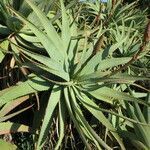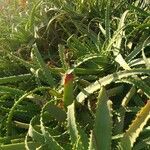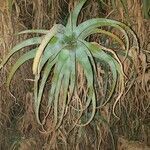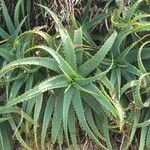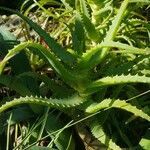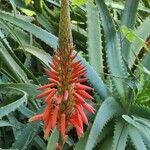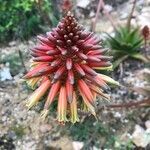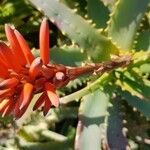Many-branched shrub 2-3 m high. Leaves erect to spreading, falcately deflexed, 50-60 cm long, 5-7 cm broad at base, narrowing to apex; adaxial surface dull green to grey-green; abaxial surface dull green; margins with pale teeth 3-5 mm long. Inflorescence simple, to 90 cm tall; scape subtended by bracts c. 20 mm long and 15 mm wide. Racemes conical to elongate-conical, 20-30 cm long, 10-12 cm diam.; flowers congested; bracts ovate, acute to obtuse, 15-20 mm long; pedicels 35-40 mm long. Perianth trigonous-cylindrical, slightly constricted above ovary, 40 mm long, scarlet; sepals and petals sub-acute, spreading, the 2 whorls not cohering. Stigma exserted 5 mm. Fruit not seen.
Much-branched arborescent shrubs up to 3 m tall; if on rock faces then solitary to few-branched. Leaves many per rosette, spreading to slightly reflexed, 250-600 x 20-70 mm, blue-green. Inflorescence usually a simple, rarely branched, dense, broadly conical, ±800 mm long raceme; bracts ovate-acute, 12-20 x 7-12 mm, many-nerved. Flowers scarlet throughout, or becoming yellow at anthesis, 30-40 mm long; pedicels 20-40 mm long. Anthers exserted 1-5 mm. Ovary 4-10 x 1.5-3.0 mm, green; style exserted 3-9 mm. Fruit ±22 x 6-7 mm, pale grey. Flowering season (April to) June to July, depending on locality.
Succulent, perennial shrub. Stems 2-3 m high, much branched to form arborescent shrub, only terminal portion with leaves. Leaves dull green to grey-green, without spots, 0.5-0.6 m long, margins with firm, pale teeth, usually curved forward. Inflorescences several, usually simple, erect, ± 0.8 m high, with conical to elongate-conical, dense racemes. Flowers scarlet, orange or occasionally yellow; stamens and stigma exserted. Flowering time May-Aug.
Succulent, perennial shrub; caulescent. Stems 2-3 m high, much branched to form an arborescent shrub. Leaves dull green to grey-green, without spots, 0.5-0.6 m long; margins with firm, pale teeth, usually curved forward. Flowers: inflorescence usually simple, erect, ± 0.8 m high, with conical to elongate-conical, dense racemes; stamens and stigma exserted; perianth ± 40 mm long, orange, scarlet, or occasionally yellow; May-Aug.
A mounding shrub. It forms clumps. It can be 2-3 m tall. The stems are 2-3 m long. The leaves are in crowded rinds at the ends of stems. The leaves are spreading and sword shaped. They are 50-60 cm long by 5-7 cm wide. They are dull green with pale teeth along the edge. The leaves taper to a long tip. They curve downwards. The flowering arrangement is upright or horizontal and usually un-branched. The flowers hang down.
Succulent shrub to 3 m, much branched with leaves clustered at branch tips. Leaves dull green to grey-green, without spots, 50-60 cm long; margins with firm, pale teeth, usually curved forward. Racemes conical to elongate conical, usually simple, ± 80 cm high. Flowers scarlet, orange-red, rarely yellow; stamens and stigma exserted.
Leaves in a dense rosette at the apex of each branch, spreading becoming recurved; lamina up to 60 cm long, 5–7 cm wide at the base, lanceolate-attenuate, greyish-green, without spots, tinged reddish in dry conditions; margin with firm forward-pointing yellow deltoid teeth 3–5 mm long and 10–15 mm apart.
A many-branched arborescent, succulent shrub, up to 3 m high. Leaves many per rosette, spreading to slightly reflexed, blue-green. Inflorescence simple, 0.8 m long. Racemes dense. Pedicels 20-40 mm long. Flowers scarlet throughout or becoming yellow at anthesis.
Perianth bright orange-scarlet, paler towards the mouth, green-tipped in bud, 35–40 mm long, c. 7 mm in diameter across the ovary, cylindric-trigonous; outer segments free to the base, tips scarcely spreading.
Raceme 20–40 × c. 10 cm, cylindric-acuminate, very densely flowered, the buds covered by the bracts; bracts 15–20 × 10–12 mm, broadly ovate, scarious, brown, many-nerved; pedicels 30–40 mm long.
Inflorescences 1–4 from each rosette, erect, up to c. 60 cm tall; peduncle simple or rarely with one short branch, with a few sterile bracts below the raceme.
Stem to 30 cm in diameter, branching at or near the base, much branched above; stem and branches usually covered with persistent dried leaf remains.
Seeds 1.75 × 3.5 mm, black with very narrow, whitish wings.
Capsule 17–18 × 7 mm, oblong-ovoid, yellowish-brown.
Stamens and stigma exserted c. 5 mm.
Shrub 3–5 m high.

